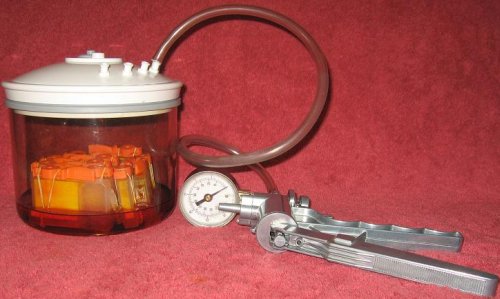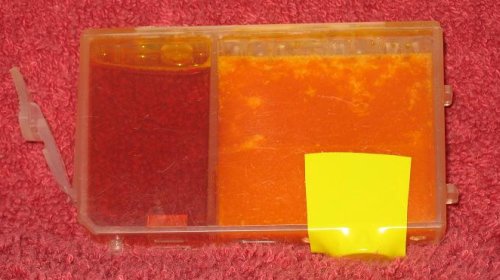This article describes a cheap and simple way to vacuum fill Canon BCI-6, and similar cartridges. The only cost besides ink is a vacuum chamber and a vacuum pump. If you’re lucky, you can get a loaner manual vacuum pump from an auto supply store for just a few bucks or even free. That is what I did to develop this article for a total cost of under $30. Or, if you prefer, you can buy your own manual vacuum pump for about $40 or an electric one for $130. The manual pumps are designed for bleeding brake lines and the electric ones are designed for purging air conditioning lines. I bought this unit http://www.atdtools.com/showitem.php?item_id=3409 from a local auto supply store. I don’t believe it is available on line.
The vacuum chamber is available from http://www.inkjetsaver.com/vacchamber.html for $24.95 plus $4.99 shipping. It is really designed for filling cartridges with multiple colors and comes with several ports and tubes for this purpose. I just yanked the tubes off from the inside of the lid and put plugs on them. I called inkjetsaver (CompuBiz Inkjet) and found that you can special order the vacuum chamber with only one port or you can special order four extra screw-on caps that go on the unused ports on the outside of the lid for $.15 each. Either way you go, you just need one port open to connect the tube that goes to the vacuum pump.
Fortunately, the tube that comes with the manual vacuum pump has an inside diameter of 1/4″ which is the perfect size to fit snuggly on one of the ports on the top of the lid.
To get started, you need to put the original clips that came with your ink tanks (all of one color, of course) back on them. If you don’t have them, use electrical tape to cover the outlet ports. If you are filling Canon ink tanks, you can use rubber bands, like I did, to hold their clips in place.
Place the ink tanks in the bottom of the vacuum chamber upside down, that is, with the clips on top. Depending on the size of the clips, you can get ten or twelve cartridges in the vacuum chamber. If you don’t have enough tanks to completely fill the bottom of the chamber, use some kind of container filled with water to keep the tanks from falling over. Pill bottles work well for this purpose.
Next you want to add about an inch of ink to the chamber.
Put the lid on the chamber and connect the pump.
Here’s what it all looks like so far:
Pump until you reach at least 25 inches of vacuum on the gauge. It will take about three minutes. You will get a good work out.
Slowly release the vacuum and watch the ink flow into the tanks.
Chances are the tanks will reach about 80% full. As long as there is enough ink left in the chamber, you can repeat the process and attain almost 100% full, otherwise add more ink before repeating. Again, it’s time to take another three minutes of exercise. If you have an electric vacuum pump, you will be able to get almost 100% full with just one application.
Releasing the vacuum the second time looks like this:
It’s hard to see but the small space between the top of the sponge and the top of the cartridge gets full of ink by this process. When you remove the cartridges from the vacuum chamber, you should remove the clips from the outlet ports and set them in a location where you can afford to have the ink drain out and it will, as shown in this video:
The next step is to wash the cartridge by running water over it and then dry it with a towel. Then, blow a little air into the air vent to force some ink out of the outlet port and assure that the top of the sponge is not saturated with ink.
At this point, I stretch a piece of vinyl electrical tape across the outlet port and place the cartridge up-side-down on a counter top while squeezing the sides where the sponges are. The purpose of this is to drain the two wells that are in the serpentine path for the air vent. Continue squeezing until you no longer hear a gurgling sound and no more ink comes out of the air vent.
Whether you leave your cartridges with their original clips on or use tape, you should make sure that the outlet port is sealed until it’s time to install them in a printer. You should not seal the air vent because you want the cartridge to be able to “breathe” through its normal air vent as atmospheric pressure changes cause air to move in and out of the cartridge.
Here is a photo of the final filled cartridge:
Make sure you clean the vacuum chamber and lid after use.


Hi from the UK 🙂
I’ve been refilling BCi3/6 cartridges for a few years using refillable bodies and ink from Inkjetgoodies and then Hobbicolors. Now that my trusty iP4000s have both died I replaced them with a couple of iP4300s, not the latest models but much cheaper 🙂
I got a chip resetter for £10 (US$17) from http://www.ink.co.uk and after reading your excellent article thought I’d give vacuum filling a try!. Big problems here in the UK trying to get a tank and even a hand pump is around £30 (US$50) so I started thinking sideways …… what I came up with does the job perfectly for the vast price of £7 (US$12) … it’s a fishing accessory from Browning, used to soak pellets with flavour when Carp fishing, if you do an Ebay search for “Browning Pellet Pump” you should find lots of them.
Tried it out today and with about 40 to 50 strokes it produces sufficient vacuum to do the job 🙂
Hope this is helpful to someone and thanks for your excellent guide 🙂
Great article, was just wondering if you have tried with the cart the right way up with the outlet sitting in the ink. Then leave the air vent open at the top and then create vacuum. That would suck the air out of the carts as well as ink directly into the carts. That way you have no air going out into the sponge and out of the outlet hole.